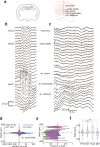Positive and biphasic extracellular waveforms correspond to return currents and axonal spikes
- PMID: 37723241
- PMCID: PMC10507124
- DOI: 10.1038/s42003-023-05328-6
Positive and biphasic extracellular waveforms correspond to return currents and axonal spikes
Abstract
Multiple biophysical mechanisms may generate non-negative extracellular waveforms during action potentials, but the origin and prevalence of positive spikes and biphasic spikes in the intact brain are unknown. Using extracellular recordings from densely-connected cortical networks in freely-moving mice, we find that a tenth of the waveforms are non-negative. Positive phases of non-negative spikes occur in synchrony or just before wider same-unit negative spikes. Narrow positive spikes occur in isolation in the white matter. Isolated biphasic spikes are narrower than negative spikes, occurring right after spikes of verified inhibitory units. In CA1, units with dominant non-negative spikes exhibit place fields, phase precession, and phase-locking to ripples. Thus, near-somatic narrow positive extracellular potentials correspond to return currents, and isolated non-negative spikes correspond to axonal potentials. Identifying non-negative extracellular waveforms that correspond to non-somatic compartments during spikes can enhance the understanding of physiological and pathological neural mechanisms in intact animals.
© 2023. Springer Nature Limited.
Conflict of interest statement
The authors declare no competing interests.
Figures







References
-
- Einevoll GT, Kayser C, Logothetis NK, Panzeri S. Modelling and analysis of local field potentials for studying the function of cortical circuits. Nat. Rev. Neurosci. 2013;14:770–785. - PubMed
Publication types
MeSH terms
Grants and funding
LinkOut - more resources
Full Text Sources
Miscellaneous

